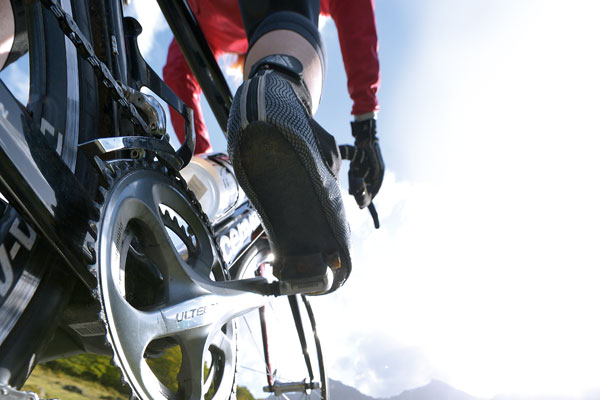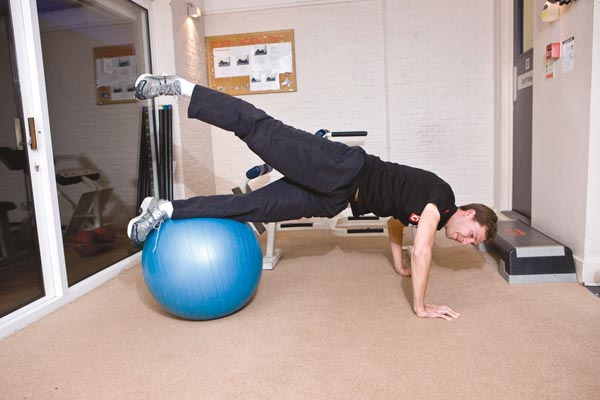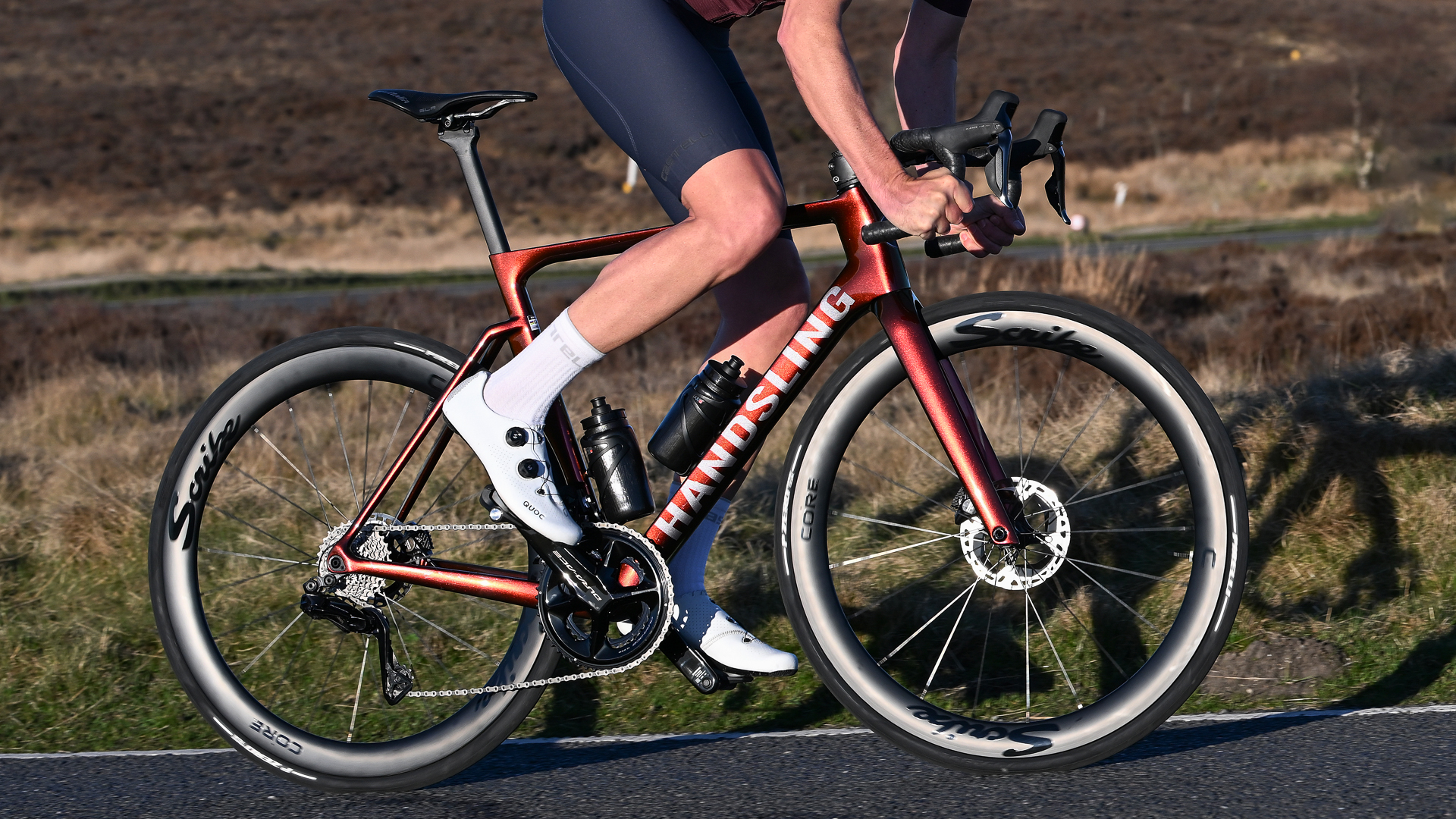Why core strength is important for cyclists
Strength training doesn't mean becoming a musclehead. Nor does it mean you have to live on protein shakes, wear tiny shorts and a vest and liberally apply fake tan.

When we refer to becoming stronger, we don't mean you have to pump iron like Arnold Schwarzenegger, but rather build strength. There is a difference. A strong, well-conditioned body can have numerous positive impacts on bike riding and general health.
It can help prevent injury, increase stability and cycling efficiency, improve bone health and even reduce the risk of developing diabetes.
Effective strength training should be apart of every cyclist's training, but is still somewhat ignored, with most people instead, focusing primarily on aerobic fitness. Of course, this is any cyclist's priority, but strength training shouldn't be disregarded.
A strong core is a fundamental part of bike riding. We spend hours upon hours in the saddle during the warmer months, and while it is the lower body pushing the power through the pedals, it is the core that keeps the body stable on the saddle. Over the course of a three to four-hour ride, our core - more specifically our abdominals, obliques, latissimus dorsi and muscles around the spine such as thoracolumbar fascia - are put under a great deal of pressure.
>>>>Six winter cycling exercises for strength and conditioning (video)
It is these muscles that help keep the body upright, provide a stable platform for the hips, thighs and knees to work from, and help minimise discomfort and injury in the back.
Back pain is one of the most common physical problems a cyclist will encounter, and a weak core will only exacerbate things.
Get The Leadout Newsletter
The latest race content, interviews, features, reviews and expert buying guides, direct to your inbox!
A strong core will also aid cycling efficiency. Without one, stability on the saddle and the lumbar/pelvic position on the bike will suffer, resulting in excessive side-to-side movement, or rocking.
The moment we start to sway from side to side, we start to run into trouble. We lose power in our legs in order to combat the rocking; we start to use other muscles to compensate our lack of core strength, which could cause further injury; and we could even suffer from saddle sores due to the friction being generate.

Hip and groin pain can also occur, as well as overuse of the hamstrings and quadriceps to compensate for the lack of gluteal, hip and spinal strength.
You may also find that your upper body, shoulders and neck start to ache due to the strong grip you are placing on the handlebars.
>>>>Cycling neck pain: how to prevent and treat it
Martin Evans is the strength and conditioning coach at British Cycling. He is employed full-time by the English Institute of Sport to work for BC. He tells us: "My take on core strength is slightly different to the traditional angle. I dislike the term ‘core' because it implies it has special properties. It is important to have a solid core, but it's only important to a point.
When you cycle, you need to be able to create force from your legs, and transfer that force through your trunk and through to your upper body
"When you cycle, you need to be able to create force from your legs, and transfer that force through your trunk and through to your upper body. If you think of your trunk as a cylinder, you have a number of dial-ups coming off, which are the muscles. Think of how many muscles are attached in that area. All of them need to be up to a certain level to be able to stabilise the trunk optimally. And that's how I envision it. We try and cover the whole cylinder."
"What I explain to the endurance riders is that if they can increase the total amount of force they can create from their hips and extensors, then they should become more efficient when riding as they won't be pushing as hard."
Bone health
Ongoing research shows a significant correlation between cycling and the onset of osteoporosis - low bone mineral density - and that in later life, cyclists do suffer more from brittle bones.
A study that was published in Medicine & Science in Sports & Exercise found that "competitive male road cyclists showed significantly lower bone mineral density in their spines than a control group of men who were moderately physically active."
The study also showed that even with a greater intake of calcium, cyclists were still more than likely to have osteopenia and osteoporosis than those in the control group. Olympic gold medallist and yellow jersey wearer Chris Boardman had to call a halt to his cycling due to osteoporosis. While it was a lack of the hormone testosterone coupled with a family history of the disease that caused his bones to become fragile, cycling certainly compounded the problem.
Boardman received drug treatment for two years but also followed a weekly exercise regimen that included weight-bearing exercises. "Cycling is good for strengthening the muscles," he told the Daily Mail at the time. "But it does very little for bones. All your weight is borne by the bike's wheels. I need high-impact activity to strengthen my skeleton."
"Strength training should be incorporated into cyclists' training. All cyclists of all levels would benefit with some form of resistance training. If everyone could do a squat, a lunge and a press-up, everyone would generally be a better athlete and reduce the risk of injury" Martin Evans, BC strength and conditioning coach
>>>>Is strength training really necessary?
There's no doubting that cycling is a fantastic cardiovascular exercise, but it puts very little impact through the joints and bones. And the body requires a fair amount of impact in order to signal to the bones to create more mass.
If you haven't been doing a lot of this type of exercise during the summer, then why not use now as the time to get some in? Certain weight exercises performed frequently such as lunges, jump squats and step-ups will help. The National Osteoporosis Society advises that "weight lifting is a good type of bone-building exercise. Leading an active lifestyle will ensure you have good balance and coordination and will also help to develop muscle strength."
Metabolic syndrome
Aerobic exercise has long been known to improve heart health, lower blood pressure and reduce the risk of diabetes. But it is only recently that weight training has been shown to have a very positive effect too. In fact, when merging the two types of training together, the health benefits could be even greater.
According to a study conducted by Hickson et al, ‘Potential for strength and endurance training to amplify endurance performance', strength training may improve endurance cycling performance by decreasing the fraction of the maximal pedal force necessary for each pedal thrust, thereby shifting the pattern of muscle-fibre recruitment towards more active type 1 fibres and resulting in reduced energy expenditure.
>>>>Which is best – cycling or running?
The results stated that: "Duathletes increased their time to exhaustion during cycling at 80 per cent of VO2max after augmenting their regular endurance training with strength training for 10 weeks."
However, it is worth nothing that this study had no control group, so these results should be interpreted with caution.
Research, has stated that people who lift weights are less likely to have metabolic syndrome - a cluster of risk factors linked to heart disease and diabetes.
The study, which looked at 5,618 US adults over a period of five years, found a significant lower prevalence of metabolic syndrome among people who reported lifting weights: 24.6 per cent, compared to 37.3 per cent in those who did not lift weights.
"Exercise professionals should strongly encourage the activity of lifting weights among adults of all ages to promote metabolic health," say the researchers.
There are even studies that indicate that effective weight training can cut the risk of developing diabetes. A study from the Harvard School of Public Health tracked the exercise habits of over 30,000 healthy men aged between 40 and 75 between 1990 and 2008, looking at time spent in various activities, as well as changes in body weight, smoking and diet.
>>>>Nutrition for cycling: 10 tips to get your food and drink dialled
After adjusting for lifestyle factors and aerobic activity, researchers found that 150 minutes of weight training per week reduced the risk of developing type 2 diabetes by over a third. The greatest reduction however, came from a combination of aerobic and resistance training, with 150 minutes of mixed activity slashing risk by up to 59 per cent.
"This study provides clear evidence that weight training has beneficial effects on diabetes risk over and above aerobic exercise, which are likely to be mediated through increased muscle mass and improved insulin sensitivity," said senior author Frank Hu.
"To achieve the best results for diabetes prevention, resistance training can be incorporated with aerobic exercise."
What to do?
There are many exercises and training plans that you could try in order to build and strengthen the body. However, do approach any exercise that requires lifting heavy loads carefully, as it can be dangerous if you lift weights that are too heavy, or your technique isn't correct.
Technique is extremely important when doing any sort of strength training as the load you are bearing on your joints is magnified when they aren't in the correct position.
Before you think about weight lifting or strength exercises, take the time to think about what area you want to strengthen, the exercise that is required and how to safely perform the exercise.
"My advice is to identify the movements/exercises that you think are going to be beneficial," says Evans. "Start on the lower end of the scale, such as doing squats without weights, because you may not be used to the loads.
"Some people overload too quickly and incur injuries. Get the technique right as well. Incorrect technique when using weights will cause injuries. If you're starting out, use more machine-based weights where the body is more stable. That will help. Remember, a stronger body means a stronger cyclist."
Protein loading: Eating for weight training
If you are new to weight training, then there are a few changes you can make to your diet in order to efficiently fuel the adaptation process. We spoke to Rapha-Condor nutritionist Mayur Ranchordas, who told us: "Weight training causes small, localised muscle tears - a necessary part of the adaptation process which results in an increase in strength and power.
>>>>Seven spring superfoods to put a spring in your step
This process increases protein requirements because amino acids are the building blocks of the body. There are several nutrition tips you can follow to enhance the training adaptation from weight training."
- Have a 10-15g protein feeding 30-45min before weight training to increase amino acid availability. Protein consumed before and after strength training can enhance maintenance of muscle as well as increase muscle mass.
- Have a carbohydrate and protein drink immediately after weight training to accelerate recovery and maximise training adaptation. The ideal ratio for this drink is approximately 25g of protein and 40g of carbohydrate.
- Increase protein intake to 1.8g/kg of body weight on the day of weight training and the following day to enhance protein synthesis and maximise training adaptation. For example, if you weigh 70kg: 70 x 1.8 = 126g of protein per day.
- Although protein supplements such as whey protein powder and amino acids can be convenient there is no scientific evidence to suggest that they are better than real food.
| Medium chicken breast | 25g |
| Medium salmon portion | 25g |
| Tin of tuna | 32g |
| Four slices ham/turkey | 15g |
| Three boiled eggs | 15g |
| 200g yoghurt | 15gs |
| One pint of milk | 19gs |

Thank you for reading 20 articles this month* Join now for unlimited access
Enjoy your first month for just £1 / $1 / €1
*Read 5 free articles per month without a subscription

Join now for unlimited access
Try first month for just £1 / $1 / €1
-
 Scribe Core SL+ 50 carbon wheelset - high performance, low cost
Scribe Core SL+ 50 carbon wheelset - high performance, low costScribe's Core SL+ 50 wheelset is at the lower end of the cost spectrum for carbon wheels, but its performance is impressive at any price
By Tim Russon Published
-
 Cycling Time Trials unveils alliance with UK brand Nopinz to 'improve and drive the sport forward'
Cycling Time Trials unveils alliance with UK brand Nopinz to 'improve and drive the sport forward'The UK time trialling body takes on new sponsor with a view to 'driving the sport forward'
By James Shrubsall Published